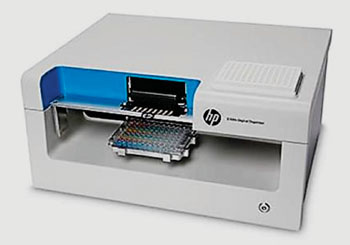Simple Method Rapidly Tests Bacteria's Susceptibility to Different Antibiotics
By LabMedica International staff writers
Posted on 27 Jul 2016
The recent emergence of bacterial infections that are resistant to many existing antibiotics is driving an urgent need for tools to quickly identify the small number of therapies that are still effective for individual patients.Posted on 27 Jul 2016
Multi-drug resistant bacteria often must be sent to specialized laboratories for analysis, leading to several days of delay before results can guide therapy. A simple and versatile method using inkjet printing technology to test such bacteria for susceptibility to antibiotics in a clinical setting has now been developed.

Image: The HP D300 digital dispensing system (Photo courtesy of Hewlett-Packard).
Scientists at the Beth Israel Deaconess Medical Center (Boston, MA, USA) explored a novel, automated, at-will broth microdilution susceptibility-testing platform. Specifically they used the modified inkjet printer technology in the HP D300 digital dispensing system (Hewlett-Packard, Palo Alto, CA, USA) to dispense, directly from stock solutions into a 384-well plate, the two-fold serial dilution series required for broth microdilution testing.
The technology was combined with automated absorbance readings and data analysis to determine minimal inhibitory concentrations. Performance was verified by testing Enterobacteriaceae for susceptibility to ampicillin, cefazolin, ciprofloxacin, colistin, gentamicin, meropenem, and tetracycline in comparison to a broth microdilution reference standard. After incubation cell growth was quantified without prior agitation by measurement of optical density at 600 nm (OD600) with an Epoch microplate reader (BioTek, Winooski, VT, USA).
In side-by-side comparisons with the gold standard microdilution method, the digital dispensing method was just as accurate. However, the digital dispensing method demonstrated significantly great reproducibility (precision) than the current gold standard, meaning that repeated digital dispensing testing more consistently yields correct results. Based on these promising initial results, it is anticipated that the D300-based methodology will enable hospital-based clinical microbiology laboratories to perform at-will broth microdilution testing of antimicrobials and address a critical testing gap.
Kenneth Smith, PhD, the first author of the study said, “With this technology, the assay can be set up in a minute or so, and testing multiple drugs for multiple patients requires minimal additional effort. We believe that our methodology will bring testing for multi-drug resistant pathogens back into clinical laboratories at the site of patient care. Testing at the site of patient care will significantly decrease the antimicrobial testing gap and allow therapy to be directed in a timely fashion against multi-drug resistant pathogens.” The study was published on June 27, 2016, in the Journal of Clinical Microbiology.
Related Links:
Beth Israel Deaconess Medical Center
Hewlett-Packard
BioTek













.jpg)